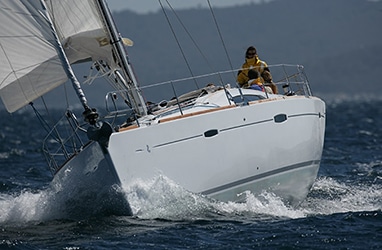
This article is an excerpt from NauticEd’s online FREE Navigation Rules Course, an interactive online sailing course for ALL sailors to learn Navigation Rules and become a safer sailor. Or if you want to learn more, upgrade to the Skipper Course Bundle to become a competent sailor!
You can learn to sail and improve your sailing with NauticEd, the international leader in sailing education.
Vessels in Restricted Visibility
The Rule
(a) This Rule applies to vessels not in sight of one another when navigating in or near an area of restricted visibility.
(b) Every vessel shall proceed at a safe speed adapted to the prevailing circumstances and conditions of restricted visibility. A power-driven vessel shall have her engines ready for immediate maneuver.
(c) Every vessel shall have due regard to the prevailing circumstances and conditions of restricted visibility when complying with the Rules [of Section I of this Part | 4 through 10].
(d) A vessel which detects by radar alone the presence of another vessel shall determine if a close-quarters situation is developing [and/or | or] or risk of collision exists. If so, she shall take avoiding action in ample time, provided that when such action consists of an alteration in course, so far as possible the following shall be AVOIDED:
(i) An alteration of course to port for a vessel forward of the beam, other than for a vessel being overtaken;
(ii) An alteration of course toward a vessel abeam or abaft the beam.
(e) Except where it has been determined that a risk of collision does not exist, every vessel which hears apparently forward of her beam the fog signal of another vessel, or which cannot avoid a close-quarters situation with another vessel forward of her beam, shall reduce her speed to be the minimum at which she can be kept on her course. She shall if necessary take all her way off and in any event navigate with extreme caution until danger of collision is over.
Discussion
What is the safe speed at night, in fog? As safe as it needs to be under good seamanship.
(d) (i) Remember the rule – two vessels approaching one another shall turn to starboard and pass port to port? This is why the rules say to avoid turning to port.
Learn Navigation Rules for Free...
A FREE 3-hour course that teaches how to stay safe, avoid collisions and accidents, and learn the “Rules of the Road”. The free Navigation Rules Course is for ALL sailors, whether you’re just learning or need a FREE refresher. Or, consider upgrading to the Skipper Course Bundle to become a fully competent skipper!
